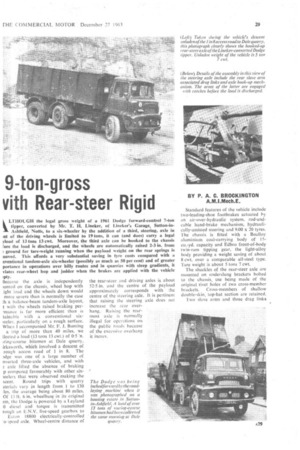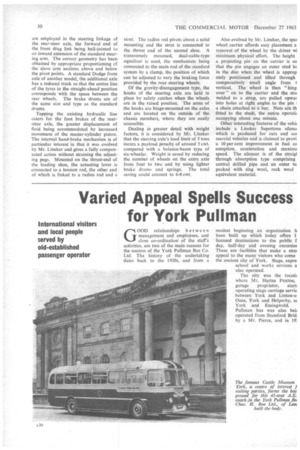9-ton-gross vith Rear-steer Rigid
Page 31

Page 32

If you've noticed an error in this article please click here to report it so we can fix it.
LTHOUGH the legal gross weight of a 1961 Dodge forward-control 7-ton tipper, converted by Mr. T. H. Lineker, of Lineker's Garage, Sutton-in
Ashfield, Notts, to a six-wheeler by the addition of a third, steering, axle in int of the driving wheels is limited to 19 tons, it can (and does) carry a legal yload of 13 tons 13 cwt. Moreover, the third axle can be hooked to the chassis tore the load is discharged, and the wheels are automatically raised 2-3 in. from : ground for tare-weight running when the payload weight on the rear springs is noved. This affords a very substantial saving in tyre costs compared with a aventional tandem-axle six-wheeler (possibly as much as SO per cent) and of greater porlance in operations over hilly routes and in quarries with steep gradients, it viates rear-wheel hop and judder when the brakes are applied with the vehicle tpty.
Because the axle is independently nutted on the chassis, wheel hop with ight load and the wheels down would more severe than is normally the case th a balance-beam tandem-axle layout, t with the wheels raised braking per-mance is far more efficient than is tamable with a conventional sixteeter, particularly on a rough surface. When I accompanied Mr. E I. Bunting a trip of more than 40 miles, we llectcd a load (13 tons 13 cwt.) of 0-5 'rt. [ring-course bitumen at Dale quarry, irksworth, which involved a descent of rough access road of 1 in 8. The Age was one of a large number of nverted three-axle vehicles, and with : axle lifted the absence of braking p compared favourably with other sixicelers that were observed making the scent. Round trips with quarry Aerials vary in length from 1 to 130 ,les, the average being about SO miles. 01 13 ft. 6 in. wheelbase in its original rm, the Dodge is powered by a Leyland 0 diesel and torque is transmitted rough an E.N.V. five-speed gearbox to
Eaton 18800 electrically-controlled o-speed axle. Wheel-centre distance of the rear-steer and driving axles is about 52-5 in. and the centre of the payload approximately corresponds with the centre of the steering axle. It is pertinent that raising the steering axle does not increase the rear over-. hang.. Raising the rearmost axle is normally illegal for operations on the public roads because of the excessive overhang it incurs.
Standard features of the vehicle include two-leading-shoe footbrakes actuated by an air-over-hydraulic system, rod-andcable hand-brake mechanism, hydraulically-assisted steering and 9.00 x 20 tyres. The chassis is fitted with a Boalloy aluminium coal-carrying body of ISco.-yd capacity and Edbro front-of-body twin-ram tipping gear, the light-alloy body providing a weight saving of about 8 cwt. over a comparable all-steel type. Tare weight is about 5 tons 7 cwt.
The shackles of the rear-steer axle are mounted on underslung brackets bolted to the chassis, use being made of the original rivet holes of two cross-member brackets. Cross-members of shallow double-skin, top-hat section are retained.
Two slave arms and three drag links are erhployed in the steering linkage of the rear-steer axle, the forward end of the front drag link being ball-jointed to an inward extension of the standard steering arm. The correct geometry has been obtained by appropriate proportioning cf the slave arm sections above and below the pivot points. A standard Dodge front axle of another model, the additional axle has a reduced track so that the centre line of the tyres in the straight-ahead position corresponds with the space between the rear wheels. The brake drums are of the same size and type as the standard drums.
Tapping the existing hydraulic line caters for the foot brakes of the rearsteer axle, the greater displacement of fluid being accommodated by increased movement of the master-cylinder piston. The internal hand-brake mechanism is of particular interest in that it was evolved by Mr. Lineker and gives a fully compensated action without straining the adjusting pegs. Mounted on the thrust-end of the leading shoe, the actuating lever is connected to a tension rod, the other end of which is linked to a radius rod and a
strut. The radius rod pivots about a solid mounting and the strut is connected to the thrust end of the second shoe. A transversely mounted, dual-cable-type equalizer is used, the mechanism being connected to the main rod of the standard system by a clamp, the position of which can be adjusted to vary the braking force provided by the rear steering wheels.
Of the gravity-disengagement type, the hooks of the steering axle are held in place by safety catches when the wheels are in the raised position. The arms of the hooks are hinge-mounted on the axles and are located on the outside of the chassis members, where they are easily accessible.
Dealing in greater detail with weight factors, it is considered by Mr. Lineker that the steering axle's load limit of 5 tons incurs a payload penalty of around 5 cwt. compared with a balance-beam type of six-wheeler. Weight is saved by reducing the number of wheels on the extra axle from four to two and by using lighter brake drums and springs. The total saving could amount to 6-8 cwt.
Also evolved by Mr. Lineker, the spa] wheel carrier affords easy placement a removal of the wheel by the driver wi minimum physical effort. The height a projecting pin on the carrier is su that the pin engages an outer stud hc in the disc when the wheel is approp ately positioned and tilted through comparatively small angle from t vertical. The wheel is then " hing over on to the carrier and the stui welded to a strap, are pulled upwar into holes at right angles to the pin a chain attached to a bar. Nuts are th fitted to the studs, the entire operath occupying about one minute.
Other interesting features of the vehic include a Lineker Supertone silenci which is produced for cars and col mercial vehicles and is claimed to provi a 10 per cent improvement in fuel co sumption, acceleration and maximu speed. The silencer is of the straigl through absorption type comprising central drilled pipe and an outer tu packed with slag wool, rock wool equivalent material.
















































































